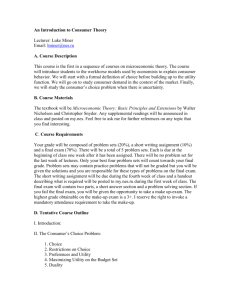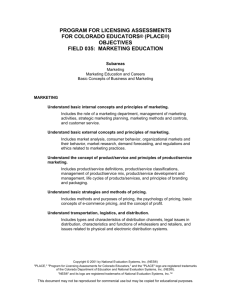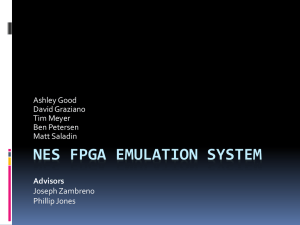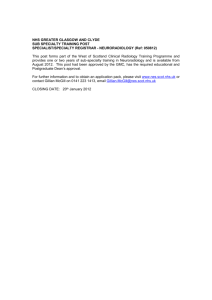NES Services of Financial Intermediaries
advertisement
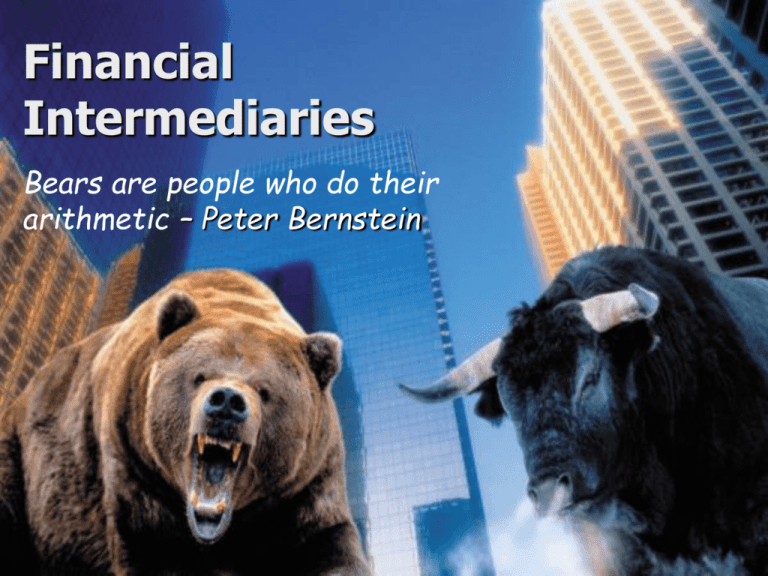
Financial Intermediaries Bears are people who do their arithmetic – Peter Bernstein Up to now What is traded? – Basic securities: stocks and bonds – Derivatives How is it traded? – Exchange vs OTC markets Who (helps to) trade(s)? – Direct vs intermediated NES FF 2005/06 2 Plan Basis for financial intermediation – Solving agency problem – Asset transformation Main types and specifics of FIs – – – – Commercial / investment banking Money management: mutual / pension / hedge funds Insurance Rating agencies Regulators and intl financial institutions NES FF 2005/06 3 Rationales for the existence of FI Transaction costs and economies of scale – Special human and technological skills – Cross-sectional and temporal reusability of information Information-based rationales – Market mechanisms may be unable to efficiently resolve information problems • • Info asymmetry: ex ante prospects / ex post return of the borrower Free-rider problem among investors NES FF 2005/06 4 Rationales for the existence of FI (2) Information-based rationales – FIs acquire information about the borrowers and monitor their performance • Diversification benefits – Who monitors the monitor? • • Debt contract: bank deposits Equity claim (in case of easily priced assets): mutual funds NES FF 2005/06 5 Services of Financial Intermediaries Brokerage: bringing together providers and users of capital without modifying the claim – Transactions services – Financial advice – Screening and sertification NES FF 2005/06 6 Services of Financial Intermediaries (2) Qualitative asset transformation: transforming the financial claims borrowers prefer into claims that savers prefer to hold – – – – – Liquidity / payment Maturity Denomination Diversification Information NES FF 2005/06 7 Commercial banks Long-term illiquid assets financed by short-term liquid deposits – Interest rate risk • Refinancing / reinvestment risk – Credit risk • Firm-specific / systematic / country risk – Off balance sheet risk (e.g., letter of credit) – Operational risk – Liquidity risk NES FF 2005/06 8 Commercial banks (2) Danger of bank runs – Sequential service constraint Eliminating bank runs – Capital requirements • But: may induce more risks – Deposit insurance / lender of last resort • But: may induce excessive risk-taking by the banks – Interbank market • But: coordination problem among banks NES FF 2005/06 9 Commercial banks (3) Securitization: selling claims against a specific part of the bank’s assets – Reducing info distortions – Better risk sharing – But: weaker monitoring incentives Which types of loans are better suited for securitization? NES FF 2005/06 10 Financing: Banks vs Capital Markets Banks Capital Markets The intermediary charges an additional layer Lower interest, but larger initial of costs (time / financial) costs Tough info requirements Close monitoring of the borrower Free-rider problem Usually, not very large (except for syndicated loans) Usually, large size The form of credit may be very flexible and project-specific (e.g., credit line) Usually, standard contract May restructure the credit in the future Harsh budget constraint May extract information rent NES FF 2005/06 11 Do banks have a future? Only the largest firms have access to bond markets – Tough information requirements to corporations issuing bonds Large companies rely on syndicated bank loans to finance large projects – Info requirement / greater control Banks are well-suited for the transfer of the control from shareholders – Banks restructure and recapitalize firms in financial distress Banks provide sophisticated financial products NES FF 2005/06 12 Is more competition always good? Recent trends in banking: – EU: integration and cross-country competition – USA: lifting restrictions on universal banking – Russia: allowing entry of foreign banks? Intensified competition in banking regarded with suspicion: – Lower rents => excessive risk taking and failures – Larger winner’s curse in bidding for loans => undue conservatism – Higher systemic risks NES FF 2005/06 13 Investment banks Securities intermediation: – Issuance by companies and governments • E.g., IPO – Purchase by investors – Financial advice on M&A, project finance, structured products, etc. Cyclical nature of earnings – Large profit in a strong market NES FF 2005/06 14 Insurance companies Transfer risks from clients to themselves for a fee – Life / health / property and casualty insurance Fixed liabilities: annuity – Long-term investments: bonds, RE, etc. Rising demand – Aging of the population Reinsurance: e.g., Lloyds Suffered from recent terror acts and catastrophes NES FF 2005/06 15 Banking in the US 1927: the McFadden act – Prohibiting interstate banking 1933: the Glass-Steagall act – Separation of commercial and investment banking – CBs cannot own voting equity 1999: the Gramm-Leach-Bliley act – Allowed consolidation of commercial banks, investment banks, and insurance companies NES FF 2005/06 16 Banking outside of the US Large universal banks – Full range of financial services – Nationwide branch network – E.g., Fuji, Sumitomo, Credit Lyonnais, Deutsche, HSBC, ABN-AMRO Substantial stock (cross) ownership – Active role in corporate management Smaller, but rising importance of security markets NES FF 2005/06 17 Money managers Specific risk-return profile – Stocks vs bonds (vs derivatives) – Conservative vs aggressive – Domestic vs intl Nature of liabilities Managerial compensation Methods of distribution Regulation NES FF 2005/06 18 Mutual funds Role of the management company – Fund family (complex) Management fee: – Asset-based: proportional to TNA – Performance-based: must be symmetric around the benchmark in the US NES FF 2005/06 19 Mutual funds (2) Open vs closed funds – Shares are “marked to market” daily Active vs passive (index) funds Load vs no-load funds (A/B/C) – Sales loads: front-end / back-end / 12b-1 fee NES FF 2005/06 20 Benefits of investing via MF Low transaction costs – Easy way to buy a diversified portfolio Customer services – Liquidity insurance Professional management – Selecting right stocks at right time? NES FF 2005/06 21 Stylized facts about MFs Largest FI in the US There are over 8,000 MFs (more than stocks) On average, MFs do not earn positive performance adjusted for risk and expenses (Mostly bad) performance persists New money flows mostly in top performers, – …but does not really flow out from poor performers Many funds deviate from their stated objectives NES FF 2005/06 22 Pension funds ‘Fixed’ liabilities – Defined contribution vs defined benefit plans – Underfunded vs overfunded pensions More conservative strategy US: 401(k) plans – Investors themselves select PFs NES FF 2005/06 23 Hedge funds More aggressive strategy – Long-short / macro / event-driven – High leverage – Usually, low systematic risk Strict entrance restrictions Management fee: – Typically, 20% of profit, with high watermark provision High attrition rate NES FF 2005/06 24 Wealth management Wealth management: mass segment ($100,000$1mln) – Portfolio management – E.g., Citibank, ING Private banking: for new riches – Financial (e.g., tax and estate) planning, cash and asset management – E.g., HSBC, UBS Family office: for old wealthy families – E.g., Piktet, Courtz NES FF 2005/06 25 Recent scandals with FIs Insider trading – October 31, 2001: Goldman Sachs economist received info about 30y US Treasuries before the official release, traders earned $3.8 mln in 8 minutes – September 2003: Goldman Sachs paid $9.3 mln to SEC Investment banks, 2002: analysts’ conflict of interests – Analysts gave overoptimistic recommendations on IB clients’ stocks – December 2002: top 10 banks paid $1.4 bln as compensation – NASD required to separate analytical and IB depts of the same company NES FF 2005/06 26 Recent scandals with FIs (2) Mutual funds, 2003: late trading – Some clients could trade at NAV fixed at 4pm on the same day Brokers’ pre-emptive trading – Brokers made own trades before executing their clients’ orders – December 2004: 5 top NYSE market-makers paid $240 mln to settle Independent consultants in the UK were convicted in the insufficient disclosure of risks of structured products sold to their clients NES FF 2005/06 27 Regulators in the US and Russia FRS / ЦБРФ – Bank regulation – Monetary policy FDIC / АСВ – Deposit insurance SEC / ФСФР – Securities operations NES FF 2005/06 28 Too big to fail? Continental Illinois Bank, a large US bank – 1983-84: many defaults on loans – May 1984: massive deposit withdrawals Help from regulators – FRS: credits via the discount window – FDIC: guarantee on all deposits, even beyond $100,000 – July 1984: FDIC purchased some loans and provided over $5 bln in capital Many smaller banks were not rescued FF 2005/06 NES 29 Too big to fail (2) “The rescue effort was less expensive than dealing with CIB’s failure” Arguments for – Direct costs of the bank’s failure – Domino effect: chain reaction Arguments against – Direct costs: FDIC recovered $1.1 bln of the $2.8 bln troubled loans it bought from CIB – Unfair competition – Incentive effects NES FF 2005/06 30 Unification of intl banking regulation 1978: the Intl Banking Act in the US – Similar regulation for domestic and foreign banks operating in the US 1987: Single European Act – Free capital flow and expansion across the countries – Similar regulations on competition, mergers, taxes, etc. for European and foreign banks 1988: uniform capital adequacy guidelines for banks of 12 developed countries – Similar regulation for domestic and foreign banks operating in the US NES FF 2005/06 31 Rating agencies Independent sertification – Credit quality – Corporate governance Major players: – S&P, Moody’s, Fitch NES FF 2005/06 32 Global trends Consolidation Increase in competition => declining margins – Both intl and across different types of FIs Traditional banking is shrinking New financial services and products growing Deregulation and unification of the regulation NES FF 2005/06 33 Conclusions Today’s hero is often tomorrow’s blockhead – Peter Bernstein
